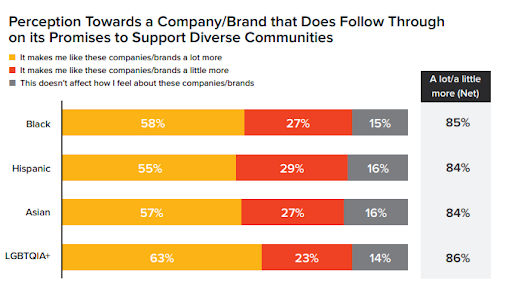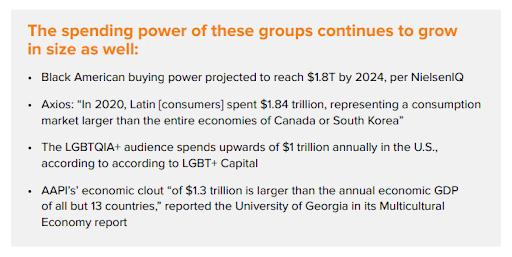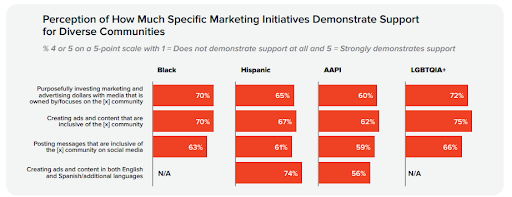
Back in the 90s, when Mark D. Walker, Co-Founder and CEO, Direct Digital Holdings, started in the media business, he heard murmurings that the consumer landscape was evolving to become more ethnically and culturally diverse.
Black Americans drove culture and wielded immense spending power, birth rates for Hispanic Americans were rising, AAPI’s spending power was significantly increasing, and LGBTQIA+ consumers were increasing in prominence. In Walker’s mind, the logical next step was for marketers to allocate a significant portion of their budget to these multicultural demographics.
In 2023, Walker hears the same discussions about the growing consumer power of multicultural groups. Yet, industry spending does not reflect the diverse consumer power.
Despite the influence multicultural groups have on mainstream culture, they are often a neglected and underserved demographic. It’s been proven that marketers who invest in these consumer groups drive sales and gain market share, so why aren’t more making the leap? A more diverse spending plan generates incremental revenue for brands.
To bolster these claims, Direct Digital Holdings conducted a study analyzing multicultural consumers’ perspectives of marketers’ ad spend habits and why it is beneficial for marketers to invest in multicultural demographics. They commissioned Horowitz Research to conduct online surveys. The total number of respondents was 1,342 U.S. adults 18+ – including over 300 respondents each from the Black, Hispanic / Latin, AAPI and LGBTQIA+ communities.
Diverse Consumers Recognize When Brands Invest In Them
Marketers are neglecting a significant portion of the population. They are missing a chance to connect with a large audience of consumers and bolster their revenue. But how can marketers connect with these audiences?
The data suggest that marginalized consumers appreciate when brands support their community through ad messaging and media support, as well as investing directly in their communities. They also spend more on brands that show support.
In addition, many of these demographics determine purchasing decisions based on whether brands show that they care about their communities. They note which brands try to reach their consumer base and spend their money accordingly.
“Consumers value that they see a message that is relevant to them, and especially when they see themselves in all aspects and all the imagery they consume,” said Alejandro Clabiorne, EVP, Executive Director, New York, at Mediahub Worldwide
It is a call to action for brands and media companies to develop an in-depth understanding of these marginalized communities and allocate a percentage of their resources toward these demographics.
Multicultural Groups Possess Strong Spending Power
Marketers who want a loyal audience with major spending power should look to multicultural communities. Data predicts significant population growth amongst these multicultural groups and their projected spending will reach new heights over the coming years.
The study highlights:
- The Hispanic and Latin populations increased to 62.1 million in 2020. It was a 23% increase from 2010. Every other demographic grew by 4.3%.
- The Black population was the second-largest population in the census. They increased to 46.9 million.
- In 2020, the APPI population was 20.6 million, and this demographic makes up 6% of the overall US population.
- The LGBTQIA+ community makes up 7.1% of the population, with a large part of that population being Gen Z.
As the graphic above notes, publishers and advertisers who neglect multicultural communities miss out on around $5 trillion of spending potential. This represents 28% of the country’s buying power.
“Clearly, this shows that underrepresented communities have considerable clout, and it’s a cautionary tale for those brands that take a one-size fits all approach to customer segmentation and marketing consumer goods and services,” said Sheryl Daija, founder and CEO of the DEI trade group BRIDGE. “For companies and brands to be successful, they need to think of inclusion as their next big growth opportunity and implement it as a business practice across the workplace, workforce, and marketplace.”
“Put Your Money Where Your Mouth Is”: Action v. Empty Promises
Marketers are aware of the changing demographics, but what methods should they use to reach these communities?
Investing in ad spend is an impactful way for advertisers to demonstrate their commitment to these audiences. Likewise, publishers who create content that resonates with these audiences and work with advertising partners who are willing to invest in them will see immense results.
Beyond seeing more content and messaging that reflects them, most respondents across all multicultural demographics hoped to see diverse hiring, leadership, and partnerships when evaluating brands they want to support. Inclusive messaging is nice, but those lofty words seem like empty promises without action.
With DEI initiatives at the forefront of every industry, multicultural communities hope this movement will usher in concrete change. That means investing in these communities, creating content they relate to, and ensuring they are decision-makers in brand decisions.
Access the complete study here: Dollars & DEI: Multicultural Consumers’ Insights on Brands’ Media Buying and Marketing Practice


